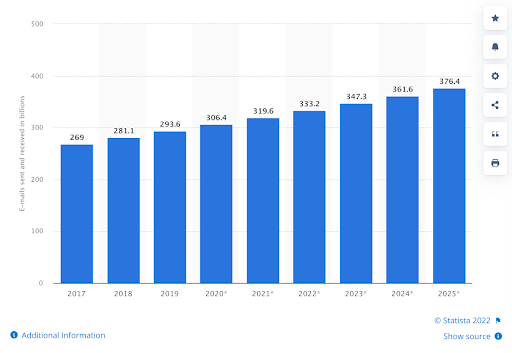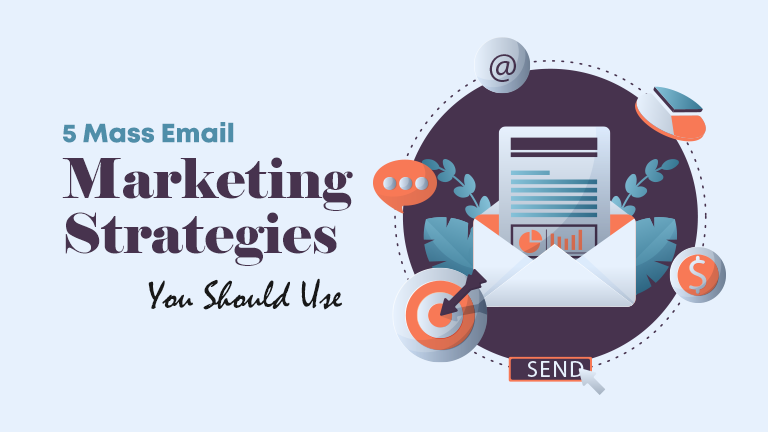Over the last few decades, we’ve heard varying views on the effectiveness of bulk email marketing.
Many marketers consider it an outdated strategy and prefer social media to improve brand exposure and consumer base. Is this, however, correct?
Is bulk email marketing on its way out? The simple answer is no.
So, what is the secret to its success, and how can you utilize mass email marketing to develop your business and attract more satisfied customers? Let’s begin by defining mass email marketing and why it’s important.
What is mass email marketing?
Mass email marketing is the practice of delivering a single message to a large number of subscribers. It’s a marketing strategy with a negative rep owing to poor execution and low conversion rates.
Typically, mass emails are sent to an unfiltered audience that may or may not be interested in what you have to offer. Customers today expect tailored emails with information and unique offers relevant to their urgent needs. As a result, marketers are increasingly relying on email automation to send emails at scale and meet their marketing objectives.
Why is mass email marketing important?
According to a McKinsey study, emails are 40 times more effective than social media in acquiring new clients. This figure is the result of a large number of emails (306.4 billion) sent and received each day in 2020 alone.
According to Statista, this rate will climb, with the email marketing channel reaching 4.6 billion global consumers by 2025.

Source: Statista
In the last decade, especially after the epidemic, mass email marketing has gone a long way. Previously, opening and viewing emails required a PC desktop, but today we offer specialized mobile applications.
Machine learning and automation are used in today’s emailing software to provide personalised information at scale. People are tired of hearing the same old themes and have shifted their focus to variety. Visual variety is also essential to the success of a marketing effort.
You may still mass email your list; but, dynamic content solutions enable you to substitute specific portions of a bulk email with content that differs depending on the receiver.
A company, for example, may send out a daily or weekly email with adverts personalized to each subscriber – such as an event invitation or a product offer based on prior interactions.
For example, a corporation may send out a daily or weekly email containing advertisements targeted to each subscriber – such as an event invitation or a product offer based on previous interactions.
5 ways to create efficient mass email campaigns
Now that you know how to create bulk email campaigns, it’s time to look at email marketing best practices in order to build high-converting campaigns that will take your efforts to the next level.
1. Email design is essential.
One of the most important aspects of any email marketing campaign is the design of the email newsletter. Email platforms have powerful email builders that allow you to design appealing and engaging email templates and enhance conversion rates. If you are unsure about creating a campaign from scratch, you may use one of their email templates.
You may pick a specific template for your niche or develop your own design and store it for future use to simplify email marketing efforts. Most email marketing systems have plenty of customization options, such as drag-and-drop builders that allow you to add different parts into your design.
Some of their email blitz templates are also mobile friendly, which is important because most people now check emails on their smartphones. Custom editors may also be used to include high-converting components such as videos, countdown timers, and product blocks into your campaigns and take them to the next level.
2. Send customised emails to your recipients by segmenting them.
To be successful with mass email marketing, you must provide tremendous value to your audience. Segmentation is the greatest way to develop massive campaigns while keeping your message focused.
You may use email software to categorize your contacts by demographics such as age, gender, or interests. With all of this data, you can generate more targeted emails that still reach a bigger audience. Having the same features for each group is critical in this phase to ensure the efficiency of a mass email campaign.
Generic communication no longer works. Consumers must recognize the value in your communications in order to act. This increases conversions and builds a loyal client base who enjoys connecting with you.
3. Check the deliverability of your emails.
A simple strategy before conducting a bulk email campaign is a content spam test. Testing your campaigns may assist you in identifying spam phrases, avoiding unsubscribes, and predicting whether your email will wind up in the spam bin.
Because new domains and IP addresses have no established reputation, Inbox Service Providers (ISPs) have no clue what to anticipate. A bulk email campaign is a one-way ticket to the spam mailbox for any new site or IP straight out of the gate, so be mindful of where you send emails in the first place.
Consider utilizing an older domain or warming up your IP address if you need to send a large number of emails at once. This method will almost probably yield better outcomes. You should also avoid contacting an old list and expecting your emails to be sent to the inbox. Even if you feel your email campaign would stimulate their interest, you should repurpose or eliminate your previous email list. It’s simple to do using email list management software.
Old records generally wind up in the spam folder, especially after the GDPR came into effect. Make certain that your lists are clean and include the contact information of those who have opted in to receive emails from you or marketing emails in general. These methods ensure good email deliverability and allow for an effective mass email campaign.
4. Keep track and evaluate the KPIs for your campaigns.
Data is one of the things you’ll need to produce great bulk email marketing. To improve your marketing activities, gather critical insights and analytics such as openings, conversions, click-through rates, and so on.
Monitoring these characteristics allows you to make important decisions regarding your next email marketing campaign. So, what key performance indicators (KPIs) would you look at to see how effective your efforts are?
- Open rate: Of all people who received your email, this is the percentage of people who opened it. A big factor that plays a significant role in your open rates is timing. Schedule emails at the right time when sending mass emails.
- Click-through-rate (CTR): This metric describes the number of people who clicked a link in your email. The goal of your content should be to get the reader to click on the call-to-action (CTA). CTRs are usually low when your copy doesn’t offer value or convince the reader to take the extra step.
- Unsubscribe rate: This is the percentage of subscribers who opted out of your email list. When you send a bulk email campaign, expect some people to unsubscribe, but don’t worry about it. Unsubscribes may be due to the frequency of emails, type of content, or many other factors. It’s essential to conduct real-time reporting and analytics to keep track of the necessary KPIs and metrics. Data-driven decisions power your email marketing strategy.
5. Campaigns should be A/B tested.
You must learn what your receivers enjoy in order to stay up with them. As a result, testing is critical to your email marketing efforts.
A/B testing determines how your audience interacts with your email efforts. You may test several versions of the same campaign to evaluate which elements resonate most with your customer persona. Understanding which aspects perform best for your target demographic is important to the success of your campaign.
You may A/B test several aspects of your email design, such as:
- Subject line
- CTA
- Visuals
- Interactive elements
A/B testing can assist you in determining the sweet spot for increasing audience engagement and improving return on investment (ROI).
 Finland
Finland Bangladesh
Bangladesh
